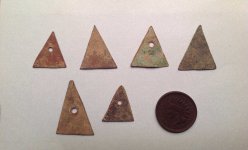Scrappy
Gold Member
- Mar 6, 2014
- 9,204
- 14,019
- 🥇 Banner finds
- 7
- Detector(s) used
- Minelab CTX 3030 & XP Deus
- Primary Interest:
- Other
Upvote
0
Here's some documented info...
Nice find!
Never seen one exactly like that before. View attachment 1482353 View attachment 1482354 View attachment 1482355 View attachment 1482356
That is Native. Here in southern New England, it's a known style, but not the most common style. What Mark posted shows the more common style here, which is a triangle, or triangle with perforation.
The age depends on where you found it in the Northeast, because the tribes persisted for longer period of time in some areas then in others. For instance, if that were found in southern New England, it would likely be from the 17th century, no later then King Philip's War of 1675-76. But, natives lived freely longer in New York and Pa., for example, and there it could date to the 1700's. Either way, it can, and most likely is, more then 200 years old, and if from the early 1600's, could be closer to 400 years old.
The English traded brass and copper kettles to natives here, and the men cut that thin sheet metal up and made points out of them. I love finding trade points where I live, but only have two as personal finds. I think that is a great find.
Excellent info and thanks for taking the time to explain. I'm located (this weekend) on Eastern Long Island. Although the Culture lasted out here for a while, most Natives were pushed out from disease and colonization by about 1660. The few remaining Native Americans from several tribes were put on a reservation by 1703. The immediate area was where I found the point was settled in 1640 where the Native population was quickly dispersed and moved East to Montauk.
Wow, most certainly one of my favorite artifacts!!
Excellent info and thanks for taking the time to explain. I'm located (this weekend) on Eastern Long Island. Although the Culture lasted out here for a while, most Natives were pushed out from disease and colonization by about 1660. The few remaining Native Americans from several tribes were put on a reservation by 1703. The immediate area was where I found the point was settled in 1640 where the Native population was quickly dispersed and moved East to Montauk.
Wow, most certainly one of my favorite artifacts!!
Excellent info and thanks for taking the time to explain. I'm located (this weekend) on Eastern Long Island. Although the Culture lasted out here for a while, most Natives were pushed out from disease and colonization by about 1660. The few remaining Native Americans from several tribes were put on a reservation by 1703. The immediate area was where I found the point was settled in 1640 where the Native population was quickly dispersed and moved East to Montauk.
Wow, most certainly one of my favorite artifacts!!

Greetings Charlie, out of curiosity I have a question, as it pertains to that local types.
Does that local type have only to do with the general shape of that particular point, or does it include the rolled over edges being bent and hammered down for reinforcement of the blade. To put it another way, are many of that point type without the folded over reinforcements?
